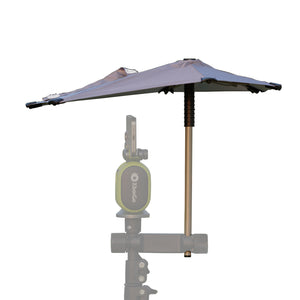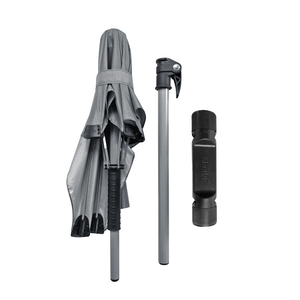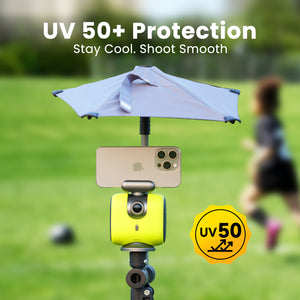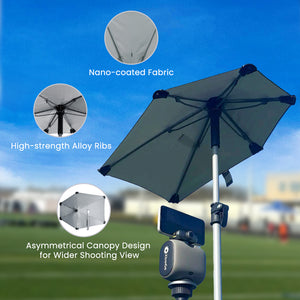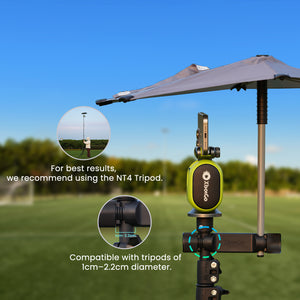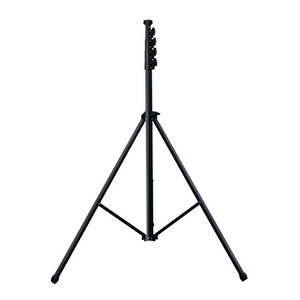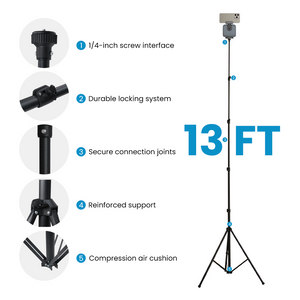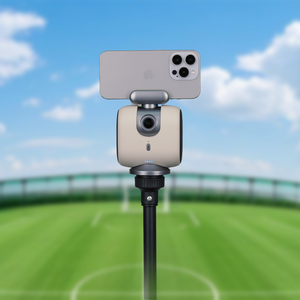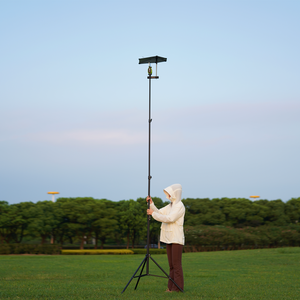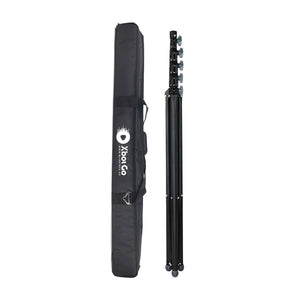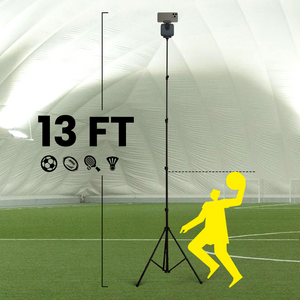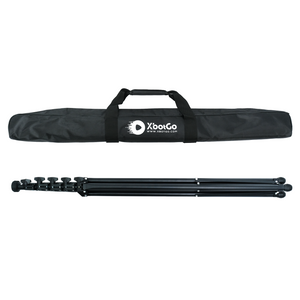XbotGo Chameleon AI Sports Camera
Soccer Tournament Recording Guide 2025: Never Miss a Goal
See that most astounding goal scored when you took a break or turned your head away from the camera? It wrenches the heart in a way that invites regret later.
Every coach, player, parent, or scout can perfectly relate to this agonizing moment amid the electrifying soccer action. Sometimes you might be attentive, but the pace at which the players dribble and score is too fast to catch.
Fortunately, capturing every goal and tournament highlight is feasible.
The following 5 soccer tournament recording techniques revolutionize your tactics of documenting the thrill and emotions on the pitch and the stadium bowl.
5 Crucial Soccer Tournament Recording Techniques
Mastering these soccer recording techniques is key to honing the professional art of sports videography. By obtaining multiple pieces of footage of fierce plays, and not average ones, you elevate the game details for exciting broadcasts, intensive player analysis, and game review.
Optimize on Camera Location and Full Field Visibility

Where the camera is standing on a tripod plays a significant role in capturing every key moment on the entire soccer field. If you place the camera at a position and height where its field of view doesn’t lock onto the whole soccer pitch, from side to side, the camera will easily miss spots it cannot cover.
It’s even a bigger tragedy when zones like the penalty box, wings, and midfield are left out of the recording. That’s where the battle for victory through intense attack and defensive mechanisms occurs, and your camera cannot fail to document.
While setting the camera on the ground is one thing, a clear view, height-wise, is another critical aspect that goes hand in hand with positioning. For instance, a busy area with fans or bench players (substitutes) standing and sitting can obscure the capture of an enormous kick. The camera accidentally shoots other objects and not the players.
Therefore, you should apply a special strategy when positioning it rather than casually setting it in any location without giving it any thought. Firstly, crowds are common in soccer tournaments, so consider using high tripods to elevate the height of the camera so that you can view only the pitch.
Also, to avoid unnecessary obstructions, scout for tripods that extend to a height of 26 ft (8m)—40 ft (12m) when unfolded. If the crowds are very chaotic, it’s smart enough to operate with more than one camera and position them in different locations. When one is tampered with, the extra camera(s) continue to record as you reposition the affected gadget.
Then, see to it that the camera stands at the midfield centreline. That’s the best area for the camera to record the whole extent of the pitch on either side of the line. Besides, the camera can hardly lose the team formations, scoring, and delaying tactics.
Precise Equipment Handling For Maximum Performance

Literally, nothing you do will improve your soccer recording if the camera and associated gear are not configured to their best potential for every tournament condition. From that perspective, a complete recording setup should run smoothly regardless of the soccer venue although sometimes managing all the equipment is a nightmare.
Usually, the change from one game or venue to another involves a change in the field environment, unpredictable weather, and varying lighting. Outdoor soccer events, in particular, face the wrath of sunlight, dust, rain, and fog, which are detrimental to the equipment's functioning. Dealing with these sudden shifts is the way to liberate yourself from interrupted soccer coverage.
As you source the right camera and accessories like the tripod and mount, which will be exposed to the atmosphere, prioritize shutter speed, ISO controls, weather-proofness, and robust designs. The biggest consideration for overall weather protection is camera umbrellas to shield the camera from the harsh elements and bird droppings; anything can fall from the sky.
You cannot forego your storage needs. To be safe, you want to store all the footage without losing even a single recording of the long soccer tournament. That’s why it’s always crucial to go for cloud-storing cameras or have several SD cards with sufficient storage capacity of 128GB to 256GB. When one is almost full, you switch to the other and transfer the files to your PC or laptop, uploading them to the cloud to create space for more soccer videos.
Have you thought of the camera’s powerhouse, the battery? This gadget determines whether the camera will record, so monitoring the battery charge from time to time is essential. Additionally, equip yourself with high-capacity batteries that can last for long tournament days and multiple soccer games.
The general rule of thumb is that every piece of equipment should have a backup. Refrain from relying on a single item in the eventuality that the primary one fails, the recordings stay seamless and undisrupted.
AI-driven Recording, Reduced Human Input

We’re naturally prone to limited focus and prolonged periods of doing the same thing. Fatigue easily kicks in, especially when making frantic switches to react to every soccer assist, formation, or pass.
Although the halftime break lasts 15 minutes, it still isn’t enough rest to re-energize you for the remaining 45 minutes of the heated movement. If for a single play, the activity might overwhelm, what about a tournament day or a circuit of a series of matches?
Occasionally, you will unavoidably find yourself sitting down to grab a nearby snack or water bottle. Apart from that, the audience's applause and jeers are frequently loud enough to divert your attention and even cause you to lose yourself in the excitement of the jumps and flag-flying. Soccer is not just a fun-filled game, but a contagious spirit.
Another distraction is responding to quick restroom runs or emergency phone calls. Something will always interrupt you, and most of the time, you cannot ignore it. Yet again, you’re undoubtedly incapable of following and capturing every player, jersey number, and ball location at all times.
It’s beyond human nature to swiftly foretell free kicks or a goal about to be scored and focus spontaneously. You fall short of early prediction and a lightning-fast reaction before you lose sight of the breathtaking spectacle.
If you grasp one or two furious chases and tackles in a row, the subsequent one will likely elude you. It’s not a matter of being erroneous, but the bigger picture is that it’s not within your human means naturally without extra help.
That’s where you have no choice but to let AI stand in for you for the most undistracted and real-time recordings. The XbotGo Chameleon Camera System has built-in AI that performs prompt tracking across the pitch, instantly noticing any object in motion. It also identifies a soccer player by jersey number, predicts subtle moves, and then turns and points the camera lens in their direction.
You can now comfortably divert, dance, chant joyfully, and immerse yourself in soccer’s vibrance, knowing the recording is perfectly taking place while you are not involved. Instead of controlling the camera, parents and coaches have freed up time and attention to watch and connect with the teams and their favorite players.
In fact, more goals get clipped than you could ever imagine. This device delivers 95% accuracy and can barely glance past any shots crossing the goal line. More than that, it’s a plus for your recording venture that it stays continuously on for up to 8 hours, enabling full tournament coverage.
Quickly Predict The Soccer Stunts

Soccer is a swift sport that requires proactiveness and speed to keep up with the pace of the players and the rolling ball on the turfgrass. From the rapid long and short passes, quick team positioning, and sudden shifts, foresight is critical for picking the signals early.
That said, when the camera is not in the correct position at the right time, it either misses the action or produces motion blur or blank parts in the recording. Just when something extraordinary is happening, recording hiccups might occur, partly due to improper camera positioning, which can be really frustrating.
So, what’s the fix? Mastering smart anticipation is one of the core sports recording skills for someone capturing soccer moments. You can predict through cues like body language, sudden bursts of speed, and the team's formation before a player strikes the ball.
At the time the players are ball-passing calmly, that’s not the moment to relax but to watch out for vigour. In no time, counter-attacks begin, with a mix of fast chases and shots aimed at the goal net. The physical battles are spontaneous; thus, you always have to keep an eye on the field, especially where the ball is.
Moreover, you ought to comprehend the different ball possession tactics, such as the Rondo possession and Tiki-Taka. A prior understanding through active soccer forums and socials helps you spot them on the field without a struggle. That’s how you easily turn yourself into a pro soccer recorder by putting in extra effort to familiarize yourself with soccer dynamics and trends.
And if you’re naturally slow to react, many of the fast game plays will take place off-camera. For that reason, you might need an AI assistant integrated into the camera to predict in seconds, turn swiftly, and adjust the frame before serious moves happen.
Prepare Strategically Before The Tournament Day
Early planning, days to the soccer tournament season, guarantees successful footage throughout the event. It takes more than gathering your recording gear and waiting for the game time to record. Without systematic planning, you’re bound for chaos in the stadium, and soccer coverage will be heavily compromised.
Stay ahead by developing a work schedule for the several games you plan to attend, slotting the venues, teams, and times for the matches. By mapping out these elements, you’ll know where you should be and when during the soccer tournament. Then, you won’t experience the hassle of sprinting between pitches in a bid not to miss the juice of the game.
Also, create time out of your routine to scout the fields the day before the tournament. When you’re there, take a pitch walk while assessing the layout to help you figure out the best location for your camera with the clearest and most epic views. If possible, you will perform your set-up testing so that on the day of the event, you will take very little time to settle in and start recording.
Plus, check that you have all your recording gear in place the day before to avoid stressful ordeals that might distract your focus. Come up with a pre-made checklist and use it to confirm that all the equipment is present when packing: cameras, fully charged batteries, tripods, blank SD cards, and a camera umbrella.
While at that, consider using a sturdy, spacious bag to carry your recording items alongside a water bottle and jerseys. Being a super mom or a soccer coach, carrying several things is inevitable, and a suitable bag comes in handy when moving between soccer fields. It goes to the extent of ensuring the car for travel has enough room for the soccer recording equipment and travel gear, in addition, if the tournament circuit is far away from your hometown.
Conclusion
Filming great videos of soccer’s full excitement is a result of a combination of AI tracking, perfect camera positioning, strategic preparations, quick anticipation, and proper recording equipment.
Therefore, changing your current recording tricks to these 5 soccer tournament recording techniques keeps your field coverage tight and consistent.
For the most satisfying recording experience, the XbotGo Chameleon camera solves the greatest setback: human deficiency. The AI algorithms replace the need for someone to operate the camera, ensuring you don’t miss any goal—time to upgrade to have the most professional footage.
XbotGo Chameleon AI Sports Camera
Capture every moment with AI-powered tracking. Perfect for coaches, parents, and athletes who want seamless footage without manual filming.







 Soccer
Soccer Basketball
Basketball Ice Hockey
Ice Hockey Rugby
Rugby










